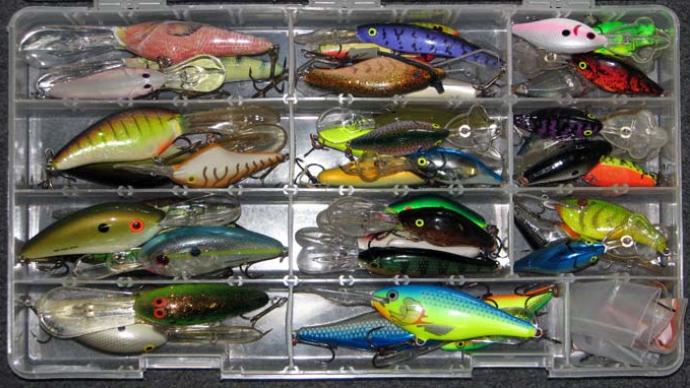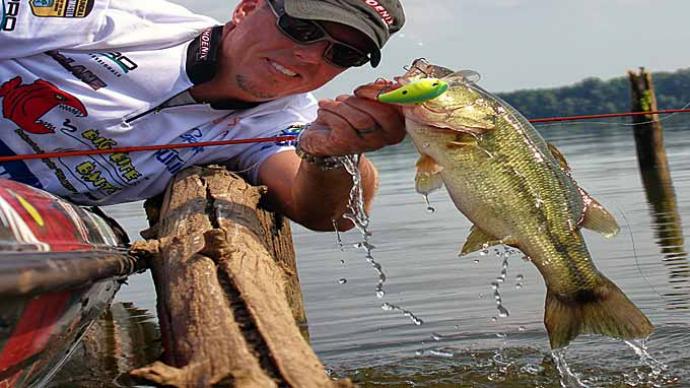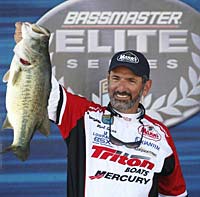
In Part I of our series, Paul Elias (1982 Bassmaster Classic winner and record holder for total weight in a four-day B.A.S.S. tournament -132.8 lbs) took on a challenge: Take a novice bass fisherman to the tackle store, outfit them with the proper equipment, and then coach them in the fundamentals of deep-water structure fishing for bass.
Now, in Part II, our crankbait master explains the techniques for discovering and catching schools of large bass around a single piece of deep cover, when to use the "Kneel-n-reel" method of gaining extra depth, the importance of boat positioning, how to walk a bait over cover, how to pick crankbait colors (and when to change them), how to prevent losing fish, using the proper hooks, whether to use rattles or not, and much more! And... you'll hear about an opportunity to take private lessons from the Classic champion himself.
Why Fish Deeper Water?
To develop deep water skills, a beginner must convince themselves there's a good reason to leave the comfort of the bank. While everyone else is fishing the shoreline, a novice without much experience in fishing open water often seeks reasons for doing so. Are there bigger fish out in this deeper water? Or are they just less molested by the other fishermen? Or is it a combination of both?
Paul quickly explains, "They're less molested, but you're more likely to find schools of fish in deeper water. On the bank, you're picking off one or two fish from a piece of cover. (And that's if you're fortunate to hit that stretch of the bank first - before the hoards of other bank-beaters get there). But when you're away from the bank, you're more apt to find a school of fish, …and you are more likely to catch bigger fish."
Schools of Larger Fish
Many professional fishermen give an impression in interviews that big fish are loners. Paul agrees that may be true when talking about huge lunker fish. But most tournaments are not won by a single trophy fish but by a solid stringer of 4, 5, and 6-pound fish that will sometimes school up.
"When you're going down the bank fishing, and you're throwing at stumps, rocks, logs, and so forth," explains our teacher, "an angler might catch three 2-pounders off of different stumps and then hit a laydown log and catch a five pounder. And throughout the day, they may catch 10 or 12 fish."
"But when an angler is out there throwing crankbaits on points, underwater islands, or road beds, (whatever it is), and a five pounder is caught, …it is possible to turn around and throw back in the same location and catch ten more five pounders."
"In deeper water, an angler never knows how many fish will be on structure with a piece of cover on it. So it's hard to know how big a school of fish will be. Now at Falcon Lake, it was a huge school of fish. (7-pounders). On other lakes, a key spot may hold just five or six fish, but those five or six fish could give an angler a 20-pound bag."
Marker Buoys

If duplicating a cast is often the key to success, the challenge is knowing exactly where that first fish was caught. So if a novice is going to work a hot location, Paul implores them to "Get some marker buoys. And always have one of those marker buoys close by when fishing deep water. Make sure it's within reach so when a big fish is hooked (or right when you get that fish close to the boat), you pick that buoy up and throw it out to have that place marked."
Line Up!
But throwing out a buoy is only half the "cast duplication" formula. Paul says, "Even though I catch a fish on a piece of cover and immediately mark that place (and here's one of the key things that I always do, and it's vital) - I also get a 'line up.' That is, I watch the direction of every cast, and I line up the spot where that fish hit my crankbait with something on the bank."
"So I drop a buoy and get a 'lineup' with my line. I must always know the cast that I just made. Because if I did just happen to hit a single stump, rock, or brush pile, I want to be able to repeat that cast. Why? Because it's possible that my next cast could be just 5 or 10 feet to the right or left of that original cast, and I might never touch that piece of cover again. And that could make all the difference in the world."
"Now, granted, if there's a big school of fish down there and you get within a couple of feet of that, you're probably going to catch another one. But if they're keyed on a certain piece of cover down there, you'll probably not catch another fish until you hit that piece of cover. And you'll be able to do it a lot quicker once you drop that buoy and get that 'lineup.'"
Paul is aware that many fishermen who buy GPS units believe their purchase now eliminates their need for buoys. "The GPS may pinpoint where your boat was sitting, but it won't tell you what degree of cast you made out on the water."
Knowing the GPS unit is not entirely as accurate or visible as a buoy, Elias teaches his students that, upon hooking a fish, cast a buoy over the side and make sure you have visually lined up your cast to some object on the horizon; such as a brightly painted house, a flagpole, tall tree, or something unique the other bank or the far side of the lake.
After playing that first fish, the next goal is to go back to that buoy and make that same cast several times to see if other bass are sitting on that particular piece of cover. But, again, contact with that cover is the key.
Taking a Different Angle
If no other bass are caught, or a hot spot cools down, Paul cautions beginners not to give up immediately. The next key is to approach that spot from different angles.
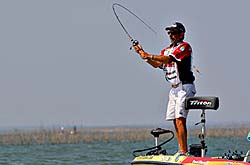
"That's a prime example of what I did at Falcon on the last day," says Paul, "and it was the key to me winning that tournament. The fish had slowed down (and I was a little disappointed on that last day with how that point had produced up until noon), so I decided to let it rest a little while, and I left."
"When I returned, instead of getting out in deep water again, I went up on top of the point and cast toward the buoy where my boat had been positioned when I had gotten there that morning. So basically, I turned that cast around and brought the bait up the point rather than down. And it was like I hit a new school of fish."
How does Paul explain the dramatic turnaround? "Well, I believe that it presented the bass with something new. The bait was coming from a different direction and was climbing up that point instead of going down it. And I think it turned that school of fish back on again."
"I've done that on several different lakes, so taking on a different angle is one of those things to tuck into the memory when you're structure fishing. If you feel like there's more fish there and they're not biting, you need to change your approach."
The "Kneel-n-Reel"
Any long-time bass fan has seen pictures of Paul Elias on his knees doing the 'kneel-n-reel' with his 8-foot rod submerged nearly to the reel. Not long after this technique began to be duplicated by others, a few noisy critics began to doubt its effectiveness. Does the kneel-n-reel really change the depth of a crankbait?
Paul counters with logic and years of experience, "Well, to me, it's simple mathematics. How can a crankbait not get any deeper by plunging the rod into the water? I mean, if you take an 8-foot rod and hold it up as high as you possibly can, do you think the crankbait will get down as deep as it normally would when you hold that tip down by the water?"
"Think about it; why do ocean-going fishing and Great Lakes charter boats use down riggers? It's the same concept. (The rod tip lowers the starting origin of the line deeper, just as a downrigger does)." Then, chuckling, Paul adds, "Anyone who can't see that needs to go back to school and take mathematics."
So when does Paul Elias decide he needs to do some kneeling-n-reeling to get down deeper? "It all has to do with the water depth that I'm fishing. There's no need to do it in just 12 feet of water. If I have a piece of cover that I'm trying to hit in 15-16 feet of water, it pays to do it."
"You've got to remember," Paul explains, "to get a bait down 16 feet deep, that lure has got to be at least 2/3's of the way back to the boat. It would be nice to get the bait down quicker. So if by kneeling-n-reeling I can get that bait down an extra foot or two quicker during the cast, I've got a better chance of hitting that piece of cover that's down in that deeper water. When I kneel-n-reel, I get the crankbait down quicker and keep it in that strike zone much longer."
Sonar Use
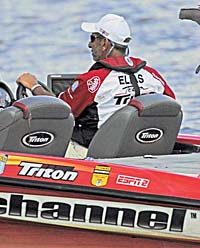
If fans follow Paul Elias around the lake, they may notice he doesn't zigzag the boat back and forth over the point using his sonar before fishing it to locate deeper cover. He replies, "Well, with points, I tend not to do that. Now if I fish a point and I don't catch anything, and yet I like the way that the point felt (and my crank indicated there was a lot of cover on the point), then I'll go back and look at it real good with the depth finder."
"But normally, what I'll do is fish the point first. And I'll fish all the way around it. If I catch fish there (or if I don't catch any fish but I like the way it looks), I'll go look at it with a depth finder."
"And I'll make sure I'm hitting everything that looks good. So in this way, I'm developing a mental picture of that point so that when I come back to fish it, I'll know exactly what is there and what I'm trying to hit with that crankbait."
When To Kneel-n-Reel?
Will Paul Elias kneel-n-reel on every point? "Well, that depends. If I'm catching fish in 12 feet of water, then I won't kneel-n-reel. But if I notice that most bites are coming off the ends of points, then yes, I'll probably kneel-n-reel."
As Paul works his way to the end of the point, he will generally kneel-n-reel when he gets to the end of every point. "I will cover the maximum depth I can at the end of that point. So if I'm throwing parallel to the contour (like if I'm sitting in 18 feet of water and I'm going to make a cast straight away - out into 18 feet of water), then I'm going to kneel-n-reel to try and get that bait to come down and hit that 18-foot water before it gets back to the boat."
Boat Positioning
The one concept Paul's students must grasp is that the deep-diving bait only achieves its maximum depth in the last third of the cast. So boat positioning is critical when attempting to hit cover in deeper water.
"Say that there's an underwater bridge crossing a creek, and that bridge is at 16 feet. An angler will have to position their boat pretty close to that bridge to reach it. So the cast will have to go as far past that bridge as possible." Correct boat positioning is based on the understanding that the crankbait will only be effectively hitting that strike zone in the last third of the cast.
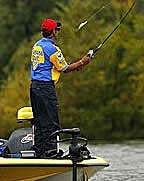
This is not the case in shallow water cranking. There is a crankbait that gets down fairly quickly and stays in the strike zone for the majority of the cast. Deep divers (with only the last third of the cast placing the crankbait in the strike zone) require far more casts to cover the same distance as a shallow bank-beater will. This is one more reason Elias says many anglers don't want to do deep-water cranking; it's a lot of work.
The Longer Cast
Are there tricks to help an angler get that extra length in the cast? "Well, that's all in having the right equipment. The longer the rod you have, the longer the cast you will make. It's all in the equipment," surmises Paul, to which he quickly adds, "…and the line. You can make a longer cast with 10-pound test than you can with 20-pound test. So it's all in how you use your equipment."
The Retrieve
"Sometimes, how you bring that bait back to the boat can make a big difference. I strongly recommend that you make a steady retrieve with the crankbait until you start hitting the cover. And then a hesitation - when you start hitting the cover. What I do is hesitate for just a split second, and then I speed it up. This way, you're imitating something that is trying to get away. I think this can get some reaction bites."
"It's important to understand that there are times when you just need to crawl that bait on the bottom, and there are times when you need to reel that bait just as hard as you can. You've got to let the fish dictate the presentation they want. So basically, I'm saying you need to try varying retrieves until you hit upon the presentation the fish want."
Cover or Fish?
As you work to imitate Paul's technique with your every cast, it may feel strange at first digging up the bottom–most fishermen are not used to that. And when your line tightens up, your brain fights furiously to interpret what is happening in the depths. "Is it cover or a fish? Do I set the hook?"
Paul knows there is no easy answer to this dilemma, "A lot of knowing when to set the hook is going to come through experience. It's all about staying in tune with your bait."
"If you are in tune with your bait, then you're going to feel it climb up over whatever is down there. The more you use that deep-diver, the more you will understand the difference between cover and fish. And… the more you can understand why you got bit when you got bit. So, all of this is going to come with experience."
Naturally, you ask, "When that bill comes up against a branch and hangs there for a second, what should I do?"
"Slow it down," says Paul. "The main thing you will want to do is point your rod right at the bait. That enables you to walk that bait over whatever cover you're coming over (…much more so than if your rod had pulled over to the side, where you are pulling across rather than up or down)."
Walking The Bait Over The Cover
Quickly you present Paul with a follow-up question, "When I walk it over the branch, am I using the rod to lift it up and over, or am I still reeling?"
Paul answers, "I'm using the rod. I usually use the rod to walk it through the cover."
"When it gets over the cover, do I pause for a second?" you ask.
"No. Speed it up!" comes the answer. Paul wants you to give the bass the impression that dinner is about to get away. "It's no different than running a little square-bill crankbait in the shallows. How many times have you run that little square bill down a log or over a stump, and by the time it hits that stump and runs over it, ...it just stops. And as the bait takes off again, a fish runs out and grabs it."
"So it's no different down there in 15 feet of water than in 3 feet of water. You want to present that bait in the same way in deep water as in shallow water."
Crankbait Colors
As you reach to remove a piece of a twig caught in a treble hook, you take a good look at the Mann's 20+. And suddenly, it occurs to you that back in the tackle store, you never asked Paul why he chose the colors he did from the thousands that were available.
"If you took the five strongest crankbait fishermen on tour today," says Paul, "and told them that they could have one color of crankbait to go out fishing with, they'd all pick something with chartreuse. And the basic reason is the main forage all over the country is bluegill."
"Most people think it is shad. Now granted, the bass may prefer shad over bluegill on a few lakes. But considering all the lakes in this country, the one forage fish present in all of them… is bluegill. That, not shad, is the main forage of the largemouth bass."
"And if you stand on a dock and look down into the water and at the bluegill swimming around, all their fins throw off a chartreuse hue. So that's why chartreuse comes into play more than anything else."

"So if an angler can only go and buy three crankbaits, I would tell them they need first to buy something with chartreuse in it. And it doesn't matter if it's got a brown-back, black-back, or green-black; it doesn't matter. (That's a color preference for the fisherman). As long as it has some chartreuse, it will work."
"And then buy shad patterns. There are all kinds of shad patterns, but picking one is important. I would recommend something with pearl or grayish-black in it and some kind of chrome (blue-back or black-back…whatever). But I recommend those two kinds of Shad patterns."
"Thirdly, I would pick a crawfish pattern. Once you have those 3 or 4 patterns, you have covered the forage of the fish. And you could take those three patterns and catch fish everywhere."
Simplify!
Paul's students have just encountered a highly simplified method of color selection. As a result, you have just been liberated from "color choice confusion" and empowered to ignore those 10,000 variations on the tackle store walls.
Even so, Paul quickly points out, "There will be times when you can find that one shad pattern out produces another shad pattern; where one bluegill pattern out fishes another bluegill pattern. But that's just 'fine-tuning' the three basic colors. So day in and day out, if you throw one of those three patterns, you will catch fish."
Elias adds another tip: "I would rather buy five of one bluegill pattern that I like than buy five different bluegill patterns. And I would do the same for the crawfish and the shad colors. The fact is if you are going to throw crankbaits, sooner or later, you're going to lose a few of them. So I would rather have a lot of crankbaits of the one color I like (that produce well) than trying to have five or more different patterns of the same style or forage base."
Many professional fishermen agree with Paul that several factors are far more critical than color (like size, depth, presentation, speed, action, etc..). Limiting crankbait selection to three or four primary colors takes care of an angler's fishing needs.
When to Experiment With Color?
When does our mentor start experimenting with color choice? "When I know I'm on a school of fish, I may intentionally change colors. For example, if I'm throwing a brown-back chartreuse and I've caught six bass, I may experiment with the shad pattern. But if it only produces two bass in the same number of casts, you can be pretty sure that I'll return to throwing the chartreuse pattern."
Fish On!
Then it happens – you hit a piece of cover, and almost instantly, you hook your first fish! Remembering what you were told, you immediately throw a buoy over the side of the boat. And at the same time, you glance down your line and store the direction of the cast in your mind – which happens to be towards a telephone pole near a tall tree on the far side.
After boating the fish, you re-establish your position - realigning yourself with the telephone pole and making duplicate casts. Finally, on the third cast, you connect again.
As if this wasn't exciting enough, five more duplicate casts resulted in a third bass.
What to Change First?

And then... it goes quiet. Repetitive casts from the exact location to the same piece of cover produces… nothing.
Were there only three bass? Should I change colors? Should I leave or move on? Sensing your dilemma, Paul surprises his crankbait students with the suggestion to change techniques first. "…pick up a Carolina rig, or Texas rig, or a jig, or something different, and throw in there."
That is precisely what happened on Lake Falcon. When the crankbait bite got quiet, Elias switched to a Carolina rig with a 10-inch Mann's Jelly worm, and the fish turned back on. His ratio of crankbait to Carolina-rig fish? He estimates it to be 80/20. But considering he won by only 4 ounces, the ability to change techniques was instrumental in his success. He gave them something entirely different from what they were used to seeing. A champion's advice is to change technique before changing color.
When To Change Colors
Are there times or situations when changing colors is the right decision to make initially? Paul reflects carefully and then says, "What makes me change colors more often than anything else is when I throw out there and get a bite with a crankbait, and the bass immediately comes up, jumps, and spits the lure out. Or… I have a fish on for a few seconds, and it comes off."
"If I start getting short strikes or losing a lot of fish on a certain color, I'll change colors and see if they will eat it. Because often, when bass hit, they're just being mean. They don't want the crankbait around them and are not hungry. So they don't want to eat it. "
"But you might put a bluegill pattern on or switch to a shad color, and the bass might swallow it. So that's the type of stuff you must feel around with."
You make a mental note: if one color of crankbait is getting a reaction, but it's just not the correct type of reaction that you're looking for, then "fine tune" the color, and you might not get as many short strikes, or lose as many fish.
Lost Fish
Losing fish on crankbaits has done more to discourage beginners than almost anything else connected to this technique. So what else can be done to reduce lost fish? "Well, we just said that you can change color," Paul reminds us, "but I would say that if you are using the right cranking-action rod and still losing fish, it's probably that you're putting too much pressure on the bass as you try to get it to the boat. The same applies if the bass is lost when it's close to the boat - the angler's technique is probably to blame."
Crankbait students often learn the hard way that big bass cannot be horsed in. Most large bass come unbuttoned due to incorrect techniques in fighting and landing fish. Paul summarizes, "They're bringing the fish to the boat too quickly or putting too much pressure on the fish at the boat."
Hooks

Another reason fish are lost has to do with hook sharpness. Until recently, if an angler wanted quality razor-sharp hooks on a crankbait, they immediately took the factory hooks off and replaced them with premium needle-sharp hooks. Today, some companies (like Mann's) attach quality hooks at the factory.
Even though Mann's uses high-quality Eagle claw hooks, Paul takes hook selection up one more level. "I use Gamakatsu treble hooks. I've always got Gamakatsu hooks on if I am in a tournament situation. And I usually go to the 2X, which is a stronger hook."
Why a thicker diameter hook? "I believe that a lighter diameter hook attached to a big fish tends to flex," explains Paul, "and this allows the fish to work the lure loose easier than with a thicker diameter hook."
To Rattle or Not To Rattle
The Mann's 20+ contains rattles. There is much controversy in bass circles concerning rattles. One side declares rattles attract more strikes. The other side insists that fish strike these noisy baits despite the rattles. Many prefer quieter baits, claiming that excessive noise can spook fish. Where does Paul stand in the controversy?
"Well, most of the baits I throw have rattles," states Elias. "I believe it is possible that you can have too much noise in a crankbait. But sometimes, it can be an attraction. I've seen times when that helps, and I have seen times when the bass didn't bite it as well."
Much of what determines if rattles are an attracting or spooking factor depends on the individual lake, the unique weather patterns, fishing pressure, and a host of other localized characteristics. Paul doesn't think you can pinpoint that.
"There are times when the bass prefer a non-rattling bait to the lures that have rattles, but most non-rattling baits are wood baits, and it could be possible that they just prefer the action of wood over plastic crankbaits. But regardless as to whether you have rattles in a bait or not, the hooks rattle so much they make a lot of noise anyway."
Scent
If rattles don't seem to be an issue for our crankbait master, scent is even less of a concern. "Scent on crankbaits is pretty much a waste of time." Next?
Size
In shallow water, there is always a debate over reducing or increasing the size of the bait. Many fishing articles encourage anglers to "match the hatch." But after looking through Paul's deep-diving crankbait box, it occurs to you that size-wise, there's not a lot of variation with deep-diving crankbaits. Paul confirms that by stating matter-of-factly, "Well, most of them are ¾ to 1 ounce, and they are pretty good size baits." Enough said.
Final Advice
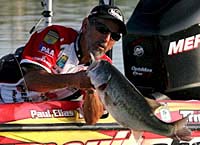
As Paul starts the boat and heads for the ramp, he gives final advice. "Just remember, all kinds of structure are out in deep water. The points are the first and easiest things to fish on a lake. When you are searching, you are searching for underwater structure, usually with some kind of cover on it. There are underwater road beds, existing bridges, blown-out underwater bridges, and submerged islands... there are all types of structure and cover you must search out."
"You've got to do your homework with a good topographic map and find all these places. So, naturally, GPS makes it a whole easier."
"But remember, you need to establish a depth. That's key. Normally, you can start looking for structures in those depths after you come up with a certain depth that most of the fish are at."
After loading the boat on the trailer, it's time to say goodbye to a Classic Champion. Even though it's been a virtual tour, our private lessons with a crankbait master have ended. He has equipped us with rods, reels, and baits, and even more importantly, the basic techniques and knowledge necessary to help us develop the confidence to venture away from the shorelines to explore the deep-water structure where large unmolested schools of bass hang out.
It's been an excellent encounter, and Paul has met our challenge head-on; mission accomplished. The only thing left is to go out and practice what the master has taught. Out there… away from the bank.
**************************
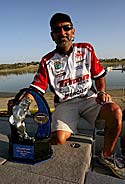
Paul Elias is the 1982 Bassmaster Classic Champion, 15 Time Bassmaster Classic Qualifier, 5 Time FLW Championship Qualifier, and world record holder for total weight in a 4-day tournament (132.8 lbs on Lake Falcon, 2008). His career winnings have now exceeded $1,000,000. He is a pro-staffer for Triton Boats, Honda Marine, Power-Pole, Mann's Bait Company, Berkley, Reel Grip, Lowrance, Costa, Seeker Fishing Rods, and Pinnacle Rods and Reels.


